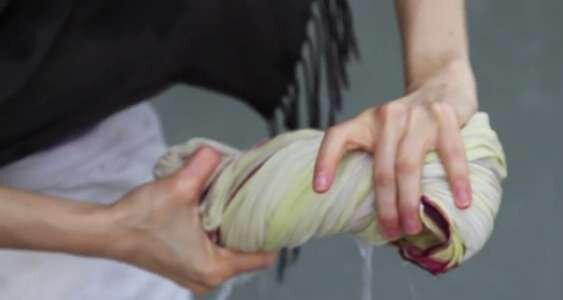Featuring:
COLLECTIVE LATHER, a video installation by Nadia Ionta (Montreal PQ)
META-ETCETERA HOVERCRAFT 1.0, a mixed media installation by Sasha Opeiko and Megan Press (Windsor ON)
WORKSPACE, a mixed media installation by Urban Fieldworkers aka: Teresa Carlesimo (Windsor, ON) and Michael DiRisio (Amherstburg ON)
For MayWorks 2013, Windsor Ontario’s labour and arts communities join with other cities across Canada to present our third annual MayWorks festival in Windsor, celebrating Labour, Arts and Community. Artists, workers, and students have met over many months to organize a collection of exhibitions, projects, events, a rally and a parade, to celebrate our creativity as a community, our dedication to the values of workers’ solidarity, social justice and human rights. The various activities will highlight our support for our city and our history of solidarity, concern for social justice and our tradition of labour arts.
2013 will mark our fourth annual MayWorks celebrations and follows in the ten year tradition of past Artcite/ University of Windsor Labour Studies program Labour Arts Festivals that took place during February from 2002 on.
For full, and most up-to-date listing of 2013 events visit our MayWorks section of our website.
In the tough economic climate of 2013, the reality of budget cuts, job insecurity and diminished employment rights has been captured in a new socioeconomic term: the precariat.
The precariat (a blend of precarious and proletariat) describes a social class of people whose lives are ‘precarious’ because their employment situation provides them with very little or no financial stability.
A related neologism, precarity, describes ‘a condition of existence without predictability or security, affecting material or psychological welfare’. Precarity is most commonly associated with workers who compete for low-paid, short-term contract retail and service jobs.
Enver Villamizar gives the keynote speech for the Precariat/ MayWorks Windsor 2013 reception (9:06) Also at
COLLECTIVE LATHER, a video installation by Nadia Ionta (Montreal PQ)
Collective Lather (2013) is Nadia Ionta’s latest from a series of performative works in India. The mixed media installation includes a video and tied bundles of clothing arranged on the floor. The video documents the artist learning and engaging in a collective washing routine with local village men in India; the everyday reality of low wage workers. The early morning domestic activity of washing the clothing higher caste clients, as well as the clothing of their wives, children, neighbors, friends, and elderly mothers and fathers is a laborious repetitive task. The artist’s presence in the daily work takes the position of a worker-helper without stipend.
The tied bundles are the cast-off clothes and other fabrics of the unknown. They reinforce the endless domestic work and as an art object the bundles become symbolic of the body in daily life; of sleeping, childbearing, suffering, and dying – the “second skin” of the adults and children they once belonged to. The installation reveals itself as a compassionate homage to communal and domestic work, which is a central element of everyday life whereby the secular (low wage worker) and the spiritual self (humanness) are inseparable.
Nadia Ionta’s artistic practice draws from cultural rituals and spiritual quests that are fundamental to the human condition even as they face the pressures of significant global change. She creates the interconnectedness between her body and psychological world to materialize everyday gestures through the lens of performative work. The durational, solitary, and collective performances in her recent works transform into a poetic language that blurs the boundaries between the notion of faith and self-creation; between the transcendental and psychological; between life and visual. These recent projects form a new and significant meaning to a wider Western audience while addressing the question of how we may come to re-vitalize and restore humanism and the spiritual self. Nadia Ionta holds a B.F.A. in Studio Arts from Concordia University (Montreal, Canada) and an M.F.A. from the School of Visual Arts, University of Windsor (Windsor, Canada).
META-ETCETERA HOVERCRAFT 1.0, a mixed media installation by Sasha Opeiko and Megan Press (Windsor ON)
Meta-Etcetera Hovercraft 1.0 is a makeshift collaborative project between Sasha Opeiko and Megan Press. It is a precariously built mobile construction, made entirely from found, repurposed, manufactured objects. The title is suggestive of mid-change (Meta-), excess and continuity (Etcetera), and the condition of being ungrounded in space by mechanical means (Hovercraft). The project explores how the consumerist production of things defines materials as temporary and disposable, implying that the labour-time invested in making is likewise provisional and transitory.
Meta-Etcetera Hovercraft 1.0 is a makeshift collaborative project between emerging Windsor artists Sasha Opeiko and Megan Press. A mobile construction/ bricolage, made entirely from found, repurposed, manufactured objects, the title is suggestive of mid-change (Meta-), excess and continuity (Etcetera), and the condition of being “ungrounded in space” by mechanical means (Hovercraft). The project explores how the consumerist production of things defines materials as temporary and disposable, implying that the labour-time invested in making is likewise provisional and transitory.
The structure consists of materials from a variety of sources: cheap household products, packaging, portable furniture, fencing that is erected temporarily around construction sites, unwanted stuff left on the side of the road, short-lived holiday ornaments, etcetera. The structure itself is temporary. After the exhibition, it will be disassembled back into modules, its identity again scattered in different directions and again redefined. The project alludes to the vulnerability of proletarian models of manufacture and how they can be easily hybridized into models of precarity. A hovercraft is associated with futuristic utopian ideals – more efficient mobility for more efficient societies, hybridization, control in defying gravity – but it is here paradoxically presented as a dystopian caricature that is clumsy and difficult to handle.
The piece is a metaphor for unsustainability, the massive autonomy of material culture, and the fears associated with this lack of control. The viewer is bodily confronted with the “atrocity of stuff”, and is invited to maneuver the Meta-Etcetera Hovercraft 1.0 in the gallery space.
Watch our time-lapse video of the making of the “Meta-Etcetera Hovercraft 1.0” (:45)
Windsor artist Sasha Opeiko holds an MFA in Visual arts from the University of Victoria (2012) and a BFA (Honours) in Visual Arts from the University of Windsor. Megan Press holds an MFA in Visual arts from the University of Victoria (2011) and a BFA (Honors with distinction, 2009) from the University of Western Ontario.
WORKSPACE, a mixed media installation by Urban Fieldworkers aka: Teresa Carlesimo (Windsor, ON) and Michael DiRisio (Amherstburg ON)
“Domestic labour, arts labour and the work that goes on in small, independent shops is often precarious and unrecognized. As a cause of the independent status of these forms of labour there are fewer opportunities for forming unions and collective action, and thus the precarity and invisibility tend to go unaddressed. This workspace attempts to illuminate certain aspects of these forms of labour. The worker appears to have just stepped out, with tools for sewing, canning and the repair of old electronics strewn throughout the work environment. Bringing to light these often overlooked tasks, we are interested in asking who is recognized within the labour movement, what work is considered “work” and how we can make visible this precarious labour. ”
— Teresa Carlesimo & Michael DiRisio, 2013
Watch our time-lapse video of the making of “Workspace” (1:04)
Teresa Carlesimo is currently an MFA Candidate at York University in Toronto. Working in sculpture-based installation, she explores contemporary social issues such as gentrification, urbanization and the built environment. She has exhibited across Canada and currently has work traveling with the International Sculpture Centre.
Michael DiRisio is a writer and visual artist. His writing has been published in Public Journal, Esse and C Magazine, and he has exhibited most recently at Artspeak Gallery in Windsor and Eyelevel Artist Run Centre in Halifax, with works in media ranging from drawing, video and installation to the more event based social practice. He is currently an MFA Candidate at the School of Visual Arts, University of Windsor.




